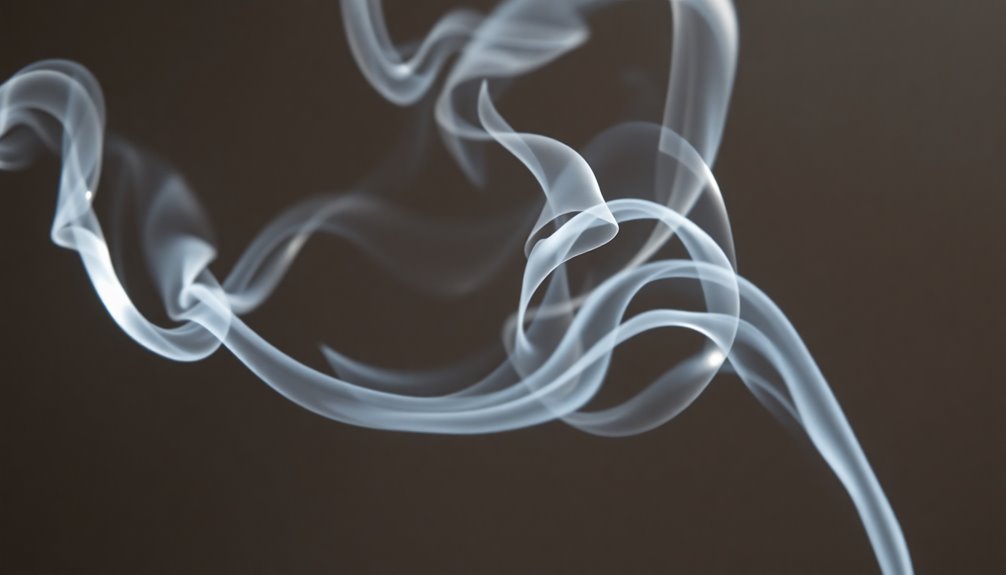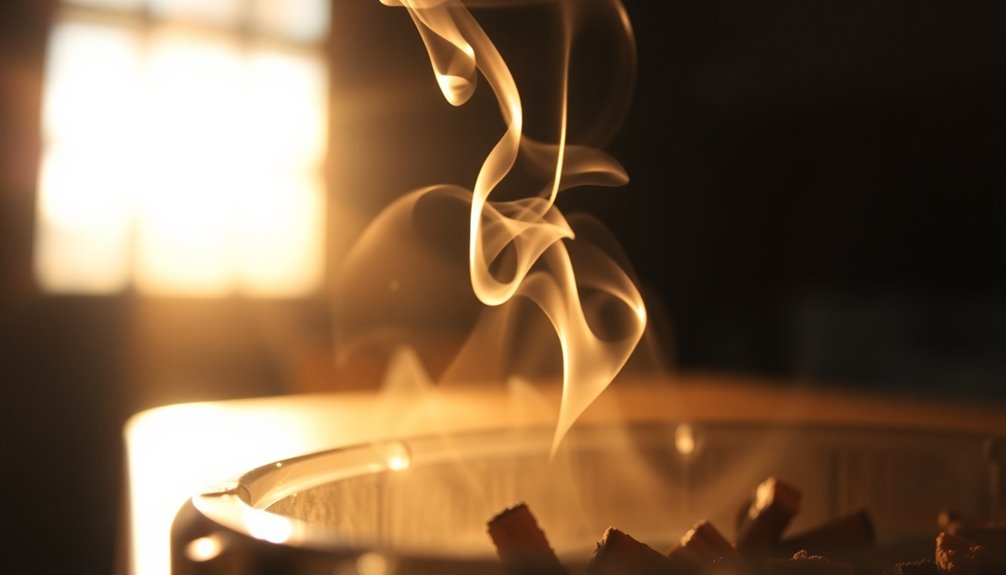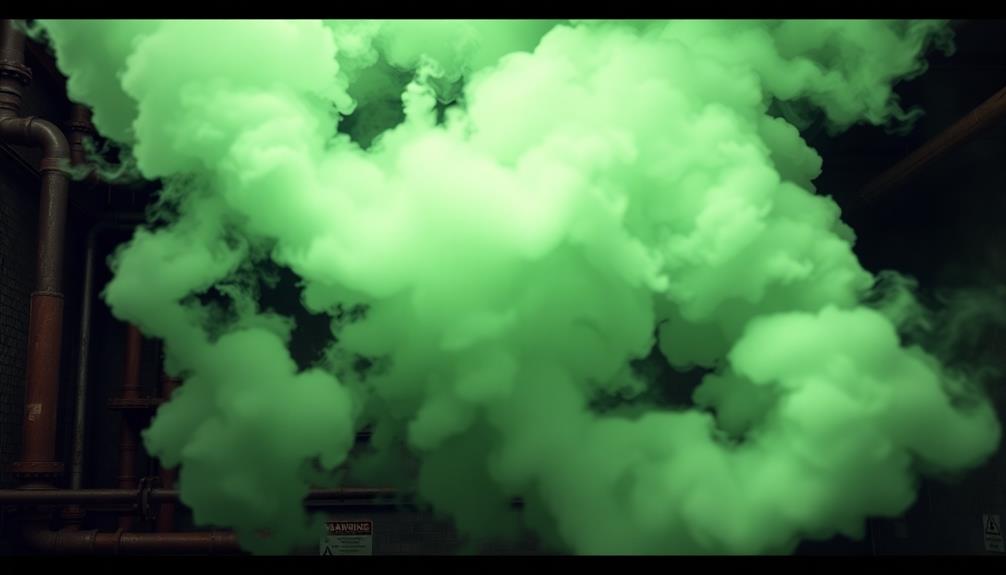Cigarette smoke has a distinct, pungent odor that you can recognize immediately. It's often described as acrid and stale, with a bitter, burnt essence that lingers long after someone has smoked. This strong smell comes from burning over 7,000 chemicals in tobacco, including nicotine and tar. You may notice it clinging to clothes, hair, and surfaces, especially in enclosed spaces like bars or homes. For many, this scent can trigger nostalgia or aversion, depending on personal experiences. Curious about the health effects and cleaning solutions for this stubborn smell? You might want to explore the impact it has further.
Key Takeaways
- Cigarette smoke has a distinct, acrid odor that is often described as bitter, stale, and pungent.
- The smell lingers due to the combustion of over 7,000 chemicals, including nicotine and tar.
- It can cling to surfaces, skin, hair, and clothing, creating a persistent odor in enclosed spaces.
- The odor intensifies in poorly ventilated areas, leading to yellowish residue on walls and ceilings.
- Emotional responses to the smell vary, with some associating it with nostalgia and others finding it aversive.
Introduction

Cigarette smoke has a unique and lingering smell that many people can recognize immediately. This odor, often described as acrid and stale, results from the combustion of over 7,000 chemicals released when tobacco is burned. These volatile compounds contribute to the strong, unmistakable scent that can permeate almost any environment. For non-smokers, the smell can be particularly offensive and easily detected, while smokers may become desensitized over time.
The impact of cigarette smoke goes beyond just the moment of smoking; it lingers long after the act has ceased. This persistent smell can cling to surfaces, skin, hair, and clothing, making it difficult to eliminate without thorough cleaning. As time passes, the odor can become even more pronounced due to its interaction with materials in the environment, leading to deeper contamination. This entrenched smell can create challenges for both smokers and non-smokers, as it becomes a permanent aspect of the space where smoking occurs. Understanding this odor is essential for managing its effects and finding effective cleaning methods to reduce its presence in your surroundings.
Description of the Smell

When you catch a whiff of cigarette smoke, it hits you with a sharp, acrid scent that's hard to forget. The odor is unmistakable, often described as a pungent, stale reminder of tobacco. This smell arises from over 7,000 chemicals, including nicotine, tar, and various carcinogens, each contributing to its offensive quality. You might notice a bitter, burnt essence that lingers long after the cigarette has been extinguished.
The residue from cigarette smoke can leave behind yellowish stains on surfaces, clothing, and even skin, intensifying the presence of that unforgettable smell. As time passes, thirdhand smoke—the remnants of earlier smoking—can continue to emit a stale odor, making it tricky to detect previous smoking activities in a room.
Every inhalation of that odor reminds you of the harsh realities associated with smoking. Its ability to cling to environments creates an unwelcome atmosphere, serving as a constant reminder of its presence. Ultimately, the lasting effects of cigarette smoke's smell can affect not just the smoker but everyone around them, making it a pervasive part of the experience.
Source and Composition

Burning tobacco releases a complex mixture of chemicals that form the distinctive scent of cigarette smoke. This smoke contains over 7,000 chemicals, including nicotine, tar, and formaldehyde, which contribute to its acrid and pungent odor. The smell is often intense and can have a lingering quality, embedding itself in fabrics and surfaces long after smoking has stopped.
When you light a cigarette, volatile organic compounds (VOCs) are released, creating the characteristic smell associated with smoking. The odor can vary based on the type of tobacco used, the additives in cigarettes, and the method of smoking, affecting both its intensity and duration.
Additionally, residual cigarette smoke, known as thirdhand smoke, continues to emit a stale odor even after the last puff. This indicates the presence of harmful chemical residues that persist in the environment, making it crucial to understand the composition of cigarette smoke. By recognizing these elements, you can better appreciate the far-reaching effects of smoking and the lasting impact it has on your surroundings.
Typical Scenarios or Environments

The strong, acrid odor of cigarette smoke is often most noticeable in environments where smoking is a regular occurrence. You might find this odor hanging heavily in bars, clubs, or homes where smoking is frequent. The stale smell of burnt tobacco mixes with chemical residue and tar, creating a distinctive scent that can linger long after the last cigarette is extinguished.
In enclosed spaces, the odor becomes even more pronounced due to poor ventilation, allowing smoke particles to accumulate and contribute to indoor air pollution. You'll likely notice a yellowish residue on walls and ceilings in these environments, reinforcing the persistent nature of cigarette smoke.
Additionally, there's the issue of thirdhand smoke, which refers to the harmful residues left behind after smoking. This can emit a subtle odor that's often undetectable yet still poses a health hazard. Whether you're walking through a smoky bar or visiting a friend's home, the combination of stale cigarette smoke and chemical residue can create an unpleasant atmosphere, impacting your experience and health.
Emotional or Cultural Associations

Cigarette smoke often carries a complex tapestry of emotional and cultural associations that can evoke a range of responses. For many, the smell sparks nostalgia, triggering memories of social gatherings where friends and family shared laughter and stories. You might find comfort in that familiar scent, linking it to cherished moments. However, cultural perceptions vary widely. In some circles, smoke symbolizes rebellion or sophistication, while in others, it signals discomfort and health risks.
Your emotional responses to cigarette smoke can be intense; it might bring relaxation and enjoyment or provoke aversion and unease. These reactions often depend on personal experiences and formative years spent in environments where smoking was common. The odor can significantly shape your mood and behavior, creating a complex interplay between memories and current feelings.
Moreover, in many communities, the scent signifies social status and lifestyle choices. It influences how individuals perceive each other and interact, sometimes serving as a marker of identity. Whether you feel drawn to it or repelled, cigarette smoke undeniably weaves itself into the fabric of social dynamics and personal narratives.
Health or Safety Considerations

Understanding the health and safety considerations associated with cigarette smoke is crucial for anyone exposed to it. The strong, pungent odor you detect isn't just unpleasant; it's a signal of harmful substances. Cigarette smoke contains over 7,000 chemicals, many of which linger in the form of smoke residue, posing serious health risks to nonsmokers, particularly children.
One significant concern is thirdhand smoke—the toxic remnants that settle on surfaces long after smoking has ceased. Exposure to thirdhand smoke can lead to health problems, including respiratory illnesses and an increased risk of cancer, even when the immediate odor isn't present. The carcinogens found in this residue can infiltrate your home environment, making it essential to take action.
If you want to protect your loved ones, especially young children, you'll need to remove cigarette odor effectively. Traditional cleaning methods often fall short, requiring extensive cleaning and renovations to eliminate harmful residues. By understanding these health risks, you can make informed decisions about your environment and safeguard your family's well-being against the dangers of environmental tobacco smoke and its lingering effects.
Final Thoughts

Addressing the lingering smell of cigarette smoke is important not just for comfort but for health, especially in homes with children or nonsmokers. The acrid odor from cigarette smoke, caused by over 7,000 harmful chemicals, can cling to skin, hair, clothing, and surfaces. This persistent smell is more than just unpleasant; it poses significant health risks, particularly through exposure to thirdhand smoke—the residue left behind after smoking.
As a responsible homeowner, you should be vigilant about identifying contaminated areas, as the stale odor may not always be detectable. Long-term exposure to these odors can adversely affect the health of children and nonsmokers, making effective odor removal crucial. Traditional cleaning methods often fall short, merely masking the smell instead of eliminating it completely.
To truly tackle the issue, consider specialized cleaning methods specifically designed to break down and remove the harmful residues associated with cigarette smoke. By investing in proper cleaning techniques, you can create a healthier environment, protecting your loved ones from the dangers of lingering chemicals and ensuring a more pleasant living space free from the negative effects of tobacco smoke.
Frequently Asked Questions
How Do You Describe the Smell of Smoke?
When you think about the smell of smoke, it often hits you with a sharp, acrid scent that lingers in the air. It's a mix of burnt materials, creating an unmistakable odor that can cling to your clothes and hair. You might notice it's heavy and stale, making you wrinkle your nose. Depending on what's burning, it can feel comforting or irritating, but it's rarely something most people enjoy smelling.
What Smells Similar to Cigarette Smoke?
When you're trying to identify smells similar to cigarette smoke, you might notice that burnt paper or charred wood often evoke a similar scent. Campfire smoke can remind you of cigarettes too, as both involve burning organic materials. Additionally, the acrid sweetness of certain food items, like caramelized sugar, can give off comparable notes. Lastly, musty or moldy odors can also mimic the stale remnants of smoke lingering in a space.
How to Describe Cigarette Smoke Smell in Writing?
When you're describing the smell of cigarette smoke in writing, think of its acrid and pungent nature. You might say it's a harsh blend of burnt tobacco and tar that clings to everything. The scent often lingers long after the smoke clears, evoking discomfort. You could compare it to burnt paper or ash, emphasizing how it can leave a musty odor in enclosed spaces, making it uncomfortable for those nearby.
Can You Smell if Someone Smoked a Cigarette?
Yes, you can smell if someone's smoked a cigarette. The odor clings to clothing, hair, and skin, often lingering long after they've finished. Even if they try to mask it with perfume or cologne, the acrid scent can still break through. If you're sensitive to smells, you might notice it immediately. Plus, the residual chemicals can stick around in the environment, making the smell detectable even when the smoker isn't present.









